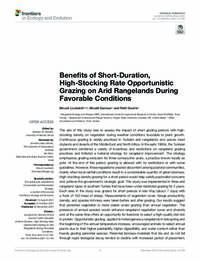Benefits of Short-Duration, High-Stocking Rate Opportunistic Grazing on Arid Rangelands During Favorable Conditions

Authors:
The aim of this study was to assess the impact of short grazing periods with high-stocking density on vegetation during weather conditions favorable to plant growth. Continuous grazing is widely practiced in Tunisian arid rangelands and across most drylands and deserts of the Middle East and North Africa. In the early 1990s, the Tunisian government combined a variety of incentives and restrictions on rangeland grazing practices and initiated a national strategy for rangeland improvement. The strategy emphasizes grazing exclusion for three consecutive years, a practice known locally as gdel. At the end of this period, grazing is allowed with no restrictions or with some guidelines. However, these regulations created discontent among pastoral communities, mainly when local rainfall conditions result in a considerable quantity of green biomass. High stocking-density grazing for a short period would help satisfy pastoralist concerns and achieve the government’s strategic goal. This study was implemented in three arid rangeland types of southern Tunisia that have been under restricted grazing for 2 years. Each area in the study was grazed for short periods in late May (about 7 days) with a flock of 150 head of sheep. Measurements of vegetation cover, forage productivity, density, and species richness were taken before and after grazing. Our results suggest that perennial vegetation is more stable under grazing than annual vegetation. The presence of annual species would enhance rangeland vegetation cover and diversity and at the same time offers an opportunity for livestock to select a high-quality diet rich in protein. Opportunistic grazing, applied to heterogeneous rangelands in late spring and the beginning of the annual temperature increase, encouraged animals to select annual plants due to their higher palatability, higher digestibility, and water content rather than heavily grazing perennial species. Perennial biomass materials that die and do not fall through rapid biological decay tended to decline with increased period of placement, resulting in further oxidation to CO2 which affects photosynthetic performance negatively and may eventually cause plant death. Trampling from high-density stocking enhances the litterfall rates and removes the oxidized plant material. These findings may contribute to strategies for addressing the extreme climatic variations that threaten rangeland and livestock sustainability.
